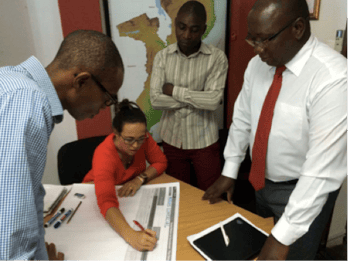
Inclusive Businesses have been part of the ‘development toolkit’ for more than a decade now. The term Inclusive Business (IB) was coined by the World Business Council for Sustainable Development in 2005, which defined IB’s as “a private sector approach to providing goods, services, and livelihoods on a commercially viable basis, either at scale or scalable, to people at the base of the pyramid by making them part of the value chain of companies’ core business as suppliers, distributors, retailers, or customers”.
Private Sector Approach and People at the Bottom of the Pyramid (BoP): a good combination?
An important question is whether or not the private sector approach actually fits the needs of the people at the BoP which they aim to reach. To be able to answer that question it's essential to measure the impact on the ground. Sinzer has developed a Template to support you in measuring the impact of Inclusive Businesses targeting the people living at the Bottom of the Pyramid.
It is widely acknowledged that it is a potentially great combination because of the social and economic benefits for both the IB as well as for the society in which they operate. Often heard reasons for this include:
- Increased profitability for the company as a result of lower supply costs, market expansion through the inclusion of low-income sectors, and greater sustainability of the business activity
- Improving living conditions for poor populations as a result of increased incomes and/or greater access to goods, services or infrastructure
However, financial constraints and lack of information and/or education make this combination sometimes very challenging. The actual positive impact of IB’s on the lives of people living at the BoP may, therefore, not always be as big as initially expected. In order to be able to answer the question whether the IB approach is successful, it is essential to measure the impact of these businesses. Therefore, Sinzer has developed a Template to measure the impact of Inclusive Businesses targeting the Bottom of the Pyramid.
Why Measure Impact?
We have developed this template, to enable you to understand what effects your mission has on the ground. How does it affect people? What has changed for them? Have their livelihoods improved as a result of being included in the value chain? Answers to these questions give you a decent insight in your performance and consequently in which area you want to or need to improve to become more successful. Besides, this information can very well be used to attract investments to improve and scale up and create greater effects. Although not every IB is at scale yet, one still can make a tremendous impact on people’s life. Insight in that impact, both positive and negative, is indispensable for an IB entrepreneur.
Insights for the IB Entrepreneur
Our ready-to-use template for measuring impact of an IB consists of different “impact areas” (as we call them), containing several indicators. Impact areas or indicators can always be removed, for instance if they are not relevant for your IB. Besides, additional impact areas as well as project specific indicators, can always be added. This saves a lot of time and work!
The Impact Areas addressed in the Template are:
- Social and Mental Wellbeing
- Entrepreneurial skills
- Standard of living
- Environment
- For example, the Impact Area Entrepreneurial Skills contains indicators related to Strategic Thinking, Trustworthiness, Productivity, Increased Financial Insight and Computer skills. This can be asked to the end beneficiaries, e.g. trainees.
- The Impact Area Environment contains indicators related to Greenhouse Gas Emissions, Water Savings, Materials, Waste, and Transport of Goods. These questions can best be answered by IB Entrepreneur.
Besides the abovementioned Impact Areas, the template contains questions related to the actual inclusiveness and the (financial) viability of the IB. To access opportunities at the bottom of the Pyramid, companies typically have to combine low costs, quality, sustainability and profitability, which often is quite a challenge. These questions aim to give you insight to what extent your business has been successful in terms of (for example) inclusiveness.
Insights for the IB Investor
As an IB Investor it could also be very valuable to use this template in the Sinzer software, since it enables you to compare the performance of several IB’s. This information is valuable to steer investments and increase effects.
The template also addresses Contextual Factors and Challenges, such as costs of including poor in the value chain, regulations, lack of education, and infrastructure. This information can be used to exert influence on local or national authorities to create a more enabling environment for the IB’s.
Example in Practice
Are you in interested to see how this template can be used in practice? Download a Practical Example of the IB Template here.
-1.jpg?width=232&name=GT%20Sinzer_logo_screen_descriptor%20(1)-1.jpg)

-1.jpg)
